Parasites continue to be a threat for the development of ruminant farming around the world. In Europe, the annual cost of livestock infections with helminths in 18 countries has been recently estimated at €1.8 billion (Charlier et al., 2020). To address parasite infections in ruminants, farmers and veterinarians frequently rely on macrocyclic lactones (MLs) such as ivermectin or eprinomectin as they are convenient to treat and prevent endo and ectoparasite infections in a single administration. MLs are usually available as pour-on, injectable solutions or as oral formulations. In many circumstances, the choice of the route of administration for MLs is driven by conveniency or pricing. While this strategy may seem economically justified, it comes with a hidden cost. Indeed, the choice of a route of administration has profound impacts on key indicators of parasite control such as pharmacokinetics and expected efficacy, environmental residues, and potential for resistance development.
Prefer to listen to this article? Click the play button below and enjoy our podcast!
Pharmacokinetics of MLs is sensitive to the route of administration
Pharmacokinetics (PK) is a pharmacological science that describes the fate of a substance when it is administered to an animal. In conjunction with pharmacodynamics, this science helps to predict substance’s efficacy in vivo. PK is largely dependent on the route of administration, and this holds true for anthelmintics in ruminants. Firstly, there is a good correlation between plasma levels of MLs and their efficacy as illustrated below in heifers challenged with Ostertagia ostertagi and Cooperia oncophora and subsequently treated with ivermectin (IVM; Bousquet-Mélou et al., 2011).
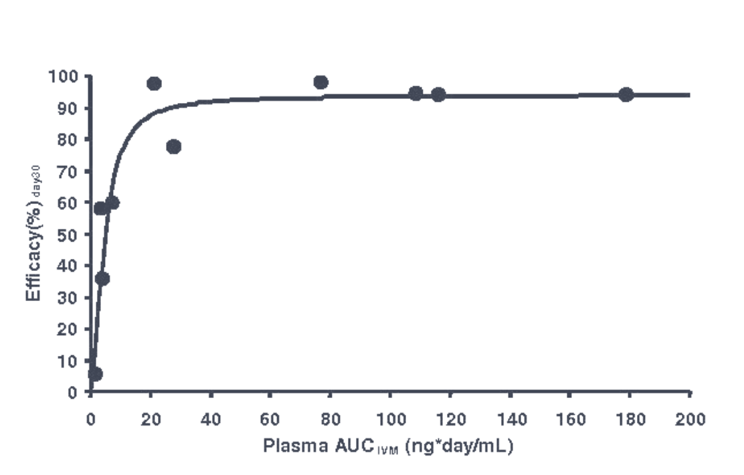
Average ivermectin (IVM) efficacy over 30 days versus plasma IVM exposure (AUCIVM from time 0 to the last quantifiable plasma concentration). Efficacy was assessed from daily faecal egg counts (FECs) and was expressed as a percentage (from 0% to 100%) corresponding to the average efficacy over the first 30 days post IVM administration. AUC stands for Area Under the Curve.
In this regard, injectable formulations of MLs are usually associated with the highest plasma concentrations in comparison with oral or pour-on routes. In a recent field trial in France, eprinomectin has been administered to ewes either subcutaneously, orally, or by topical route (Jouffroy et al., 2023). The subcutaneous route was associated with significantly higher eprinomectin concentrations while pour-on administration resulted in dramatically low drug concentrations in the serum of ewes in all flocks, frequently below the minimal active dose (red dotted lines).
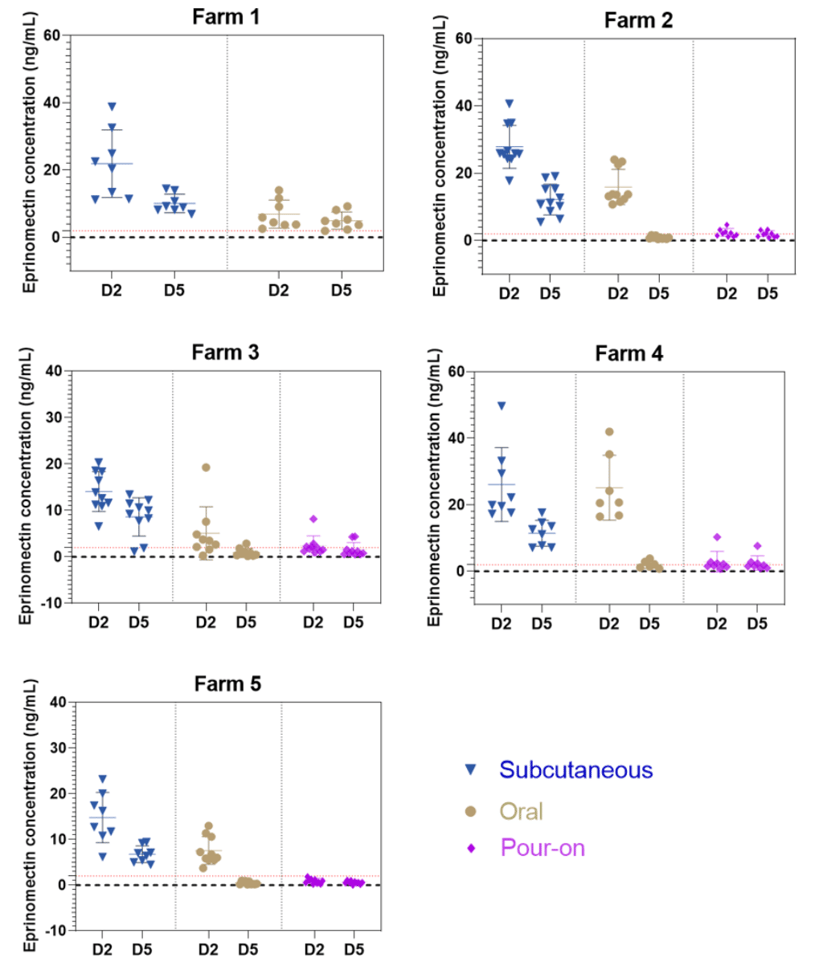
Serological concentrations of eprinomectin by farm, and by administration route. Horizontal lines indicate mean concentrations per treatment type and per day post-treatment. Blue triangle: subcutaneous group; brown dot: oral group; pink diamond: pour-on group. D2: 2 days after treatment;D5: 5 days after treatment. Red dotted line is at 2 ng/mL and represents the minimal active dose for this drug family.
In cattle, subcutaneous administration of doramectin and ivermectin have also been reported to result in higher systemic exposure and at the same time lower inter-animal variability compared to pour-on formulations (Toutain et al., 1997). These findings highlight the limited bioavailability and poor reproducibility of the topical route.
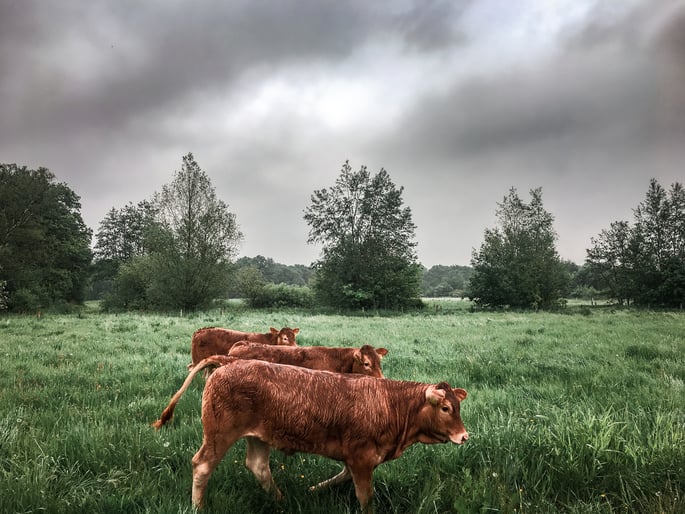
Finally, weather can also interfere with PK and influences its behavior for a given substance. The effects of simulated rain and sun exposure on the plasma disposition of ivermectin following pour-on administration have been studied in heifers (Gokbulut et al., 2011) and the findings suggest that plasma availability and disposition of ivermectin were significantly changed by simulated rain and sun exposure. In fact, the relative systemic availability of ivermectin in simulated rain group was almost three times lower compared with the control group which was kept indoor.
The grooming behavior of ruminants strongly interferes with topical administration
The grooming behavior observed in growing and adult cattle is part of their natural social behavior. Apart from the hygienic effect of coat cleaning, it may contribute to establishing and maintaining inter-individual bonds and cohesion within the group (Kiley-Worthington and de la Plain, 1983, Sato et al., 1991).
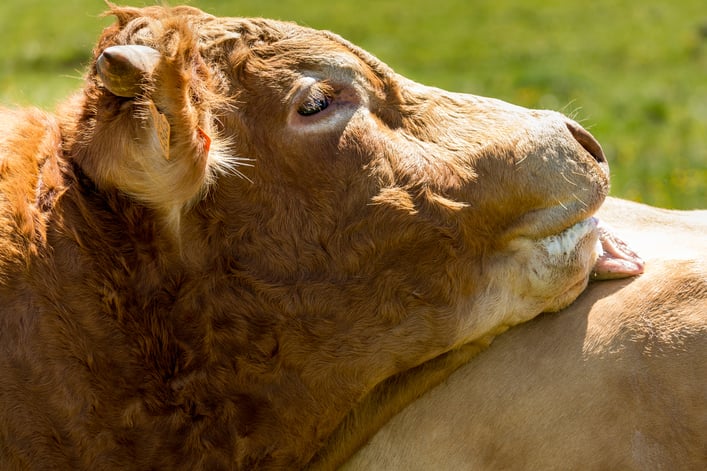
This important social trait of cattle has also profound consequences for anthelmintics such as MLs when deposited on their back. Indeed, the fate of MLs poured on the backs of cattle is largely influenced by both self- and allo-grooming. A large fraction of the MLs is ingested orally and erratically by the animal itself (Laffont et al., 2001, 2003) or exchanged with another animal in the herd (Bousquet-Mélou et al., 2004). It makes variable and unpredictable the systemic availability of macrocyclic lactones when administered topically and may result in subtherapeutic concentrations in treated and untreated cattle. In an experiment where only 40% of the herd was treated with a pour-on formulation of ivermectin, it was found that the untreated animals were under-exposed to the substance and shown partial anthelmintic efficacy (Bousquet-Mélou et al., 2011). In untreated animals, efficacy ranged from 0% to approximately 95%, with intermediary values from approximately 30% to 80% in the other untreated animals. This result questions the use of pour-on formulations for the development of targeted selective treatment in cattle as a strategy for maintaining refugia, a strategy which is currently recommended to slow down the development of resistance (Charlier et al., 2014).
Environmental impact is an additional concern when evaluating pour-on administration and its interference with the licking habits of cattle. Large differences have been observed between lickers and non-lickers after topical administration of ivermectin (Laffont et al., 2001, 2003). Nearly 70% of the pour-on dose was recovered as parent drug in the faeces of lickers vs. only 6.6% in non-lickers. This contributes to a higher and unnecessary environmental burden of parent drug. In contrast, the therapeutically equivalent subcutaneous formulation provide a lower faecal output of ivermectin.

Insights
Macrocyclic lactones are still popular anthelmintics for the control of parasitic infections in ruminants, but rapid development of resistance and environmental concerns fully justify a more careful and rationalised use of these “wonder” drugs. In addition to the adoption of treatment scheme based on refugia, prescribers and users of MLs should rely on formulations with the best pharmacokinetic profiles, that limit environmental contaminations and that can be used to slow down the development of resistance. In that sense, injectable formulations should be considered first-line’s and the use of pour-on’s should be restricted.
References
Bousquet-Mélou A, Mercadier S, Alvinerie M, Toutain PL. Endectocide exchanges between grazing cattle after pour-on administration of doramectin, ivermectin and moxidectin. Int J Parasitol. 2004;34(11):1299-1307. https://doi.org/10.1016/j.ijpara.2004.08.005
Bousquet-Mélou A, Jacquiet P, Hoste H, et al. Licking behaviour induces partial anthelmintic efficacy of ivermectin pour-on formulation in untreated cattle. Int J Parasitol. 2011;41(5):563-569. https://doi.org/doi:10.1016/j.ijpara.2010.12.007
Charlier J, Rinaldi L, Musella V, et al. Initial assessment of the economic burden of major parasitic helminth infections to the ruminant livestock industry in Europe. Prev Vet Med. 2020;182:105103. https://doi.org/10.1016/j.prevetmed.2020.105103
Charlier J, Morgan ER, Rinaldi L, van Dijk J, Demeler J, Höglund J, Hertzberg H, Van Ranst B, Hendrickx G, Vercruysse J, Kenyon F. Practices to optimise gastrointestinal nematode control on sheep, goat and cattle farms in Europe using targeted (selective) treatments. Vet Rec. 2014 Sep 13;175(10):250-5. https://doi.org/10.1136/vr.102512
Gokbulut C, Sekkin S, Aksit D, et al. The effects of simulated rain and sun exposure on the plasma disposition of ivermectin following pour-on administration in heifers. J Vet Pharmacol Ther. 2012;35(3):309-312. https://doi.org10.1111/j.1365-2885.2011.01335.x
Jouffroy S, Bordes L, Grisez C, et al. First report of eprinomectin-resistant isolates of Haemonchus contortus in 5 dairy sheep farms from the Pyrénées Atlantiques département in France [published online ahead of print, 2023 Jan 20]. Parasitology. 2023;150(4):1-9. https://doi.org/10.1017/S0031182023000069
Kiley-Worthington, M. ; Plain, S. de la. The behaviour of beef suckler cattle. 1983 pp.195pp. Publisher : Birkhauser Verlag.
Laffont CM, Alvinerie M, Bousquet-Mélou A, Toutain PL. Licking behaviour and environmental contamination arising from pour-on ivermectin for cattle. Int J Parasitol. 2001;31(14):1687-1692. https://doi.org/10.1016/S0020-7519(01)00285-5
Laffont CM, Bousquet-Mélou A, Bralet D, Alvinerie M, Fink-Gremmels J, Toutain PL. A pharmacokinetic model to document the actual disposition of topical ivermectin in cattle. Vet Res. 2003;34(4):445-460. https://doi.org/10.1051/vetres:2003014
S. Sato, S. Sako, A. Maeda,Social licking patterns in cattle (Bos taurus): influence of environmental and social factors, Applied Animal Behaviour Science, Volume 32, Issue 1, 1991. https://doi.org/10.1016/S0168-1591(05)80158-3
Toutain PL, Upson DW, Terhune TN, McKenzie ME. Comparative pharmacokinetics of doramectin and ivermectin in cattle. Vet Parasitol. 1997;72(1):3-8. https://doi.org/10.1016/s0304-4017(97)00070-8
About the author
Damien Achard (Ruminants Global Technical Manager)
Seasoned veterinarian, graduated from Ecole Nationale Vétérinaire de Nantes (France). After three years as a practitioner in central France, he pursued specialization in large animal internal medicine, completing an ACVIM residency and a Master of Sciences at the University of Montréal (2010-2014). Joining Semex Alliance as Health Manager for an IVF unit (2015-2016), he then transitioned to Ceva in 2016 as a Ruminants Global Technical Manager. Dr. Achard is an accomplished researcher, publishing on topics like downer cows, calf pneumonia or cryptosporidiosis and their associated therapies, and rational use of anthelmintics in ruminants. His ResearchGate profile (https://www.researchgate.net/profile/Damien-Achard/research) highlights his significant contributions to the veterinary field.
Explore author’s articles
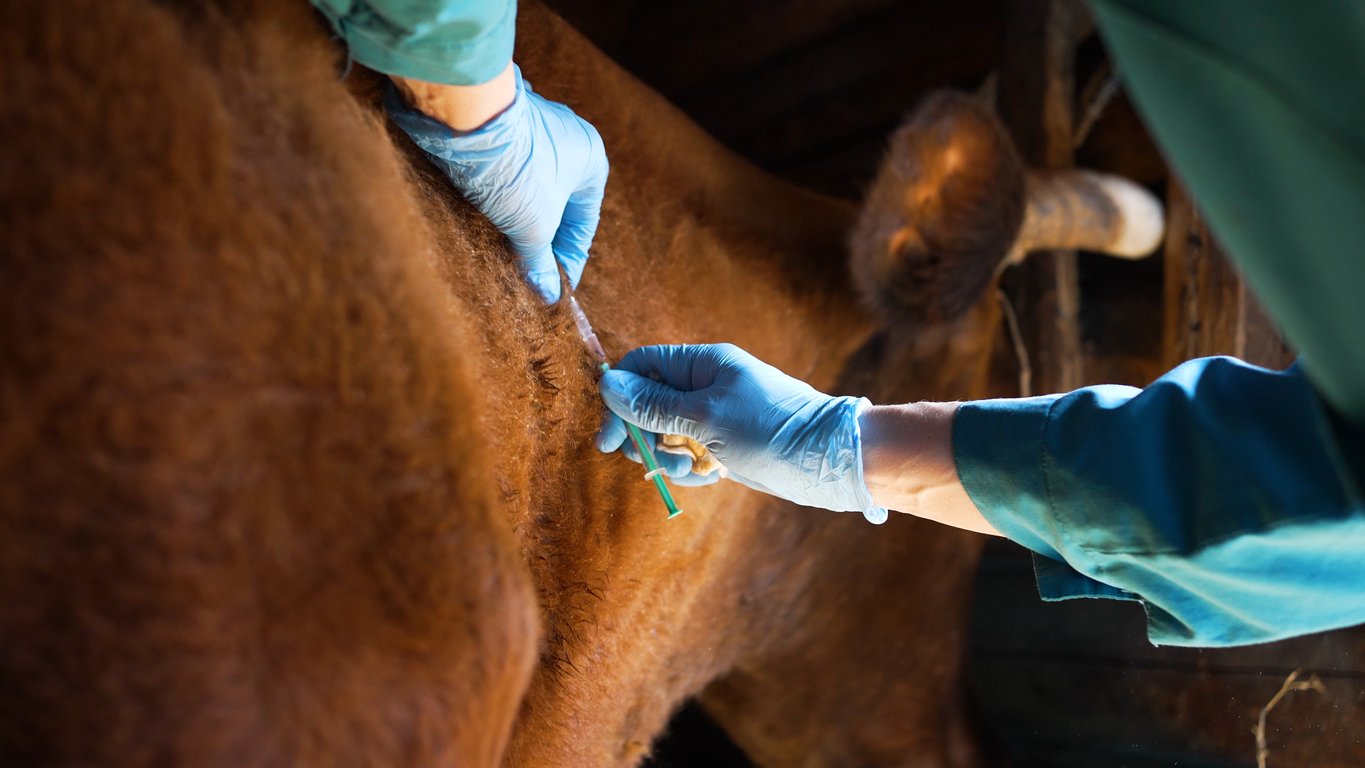

Leave your comments here